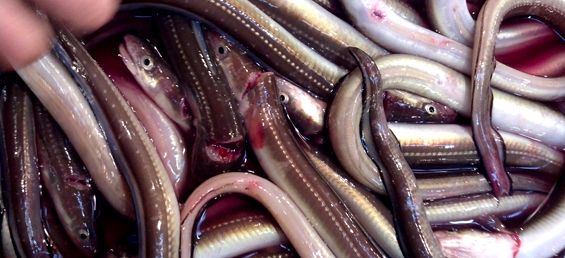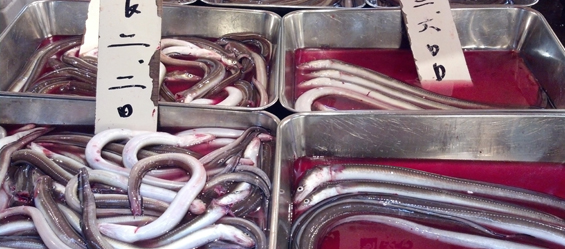| I have seen a lot of forms of slaughter, but none creeped me out more than the way I saw eels being killed at the Tsukiji Fish Market on a recent food scouting mission to Japan. My initial notes read: |
 |
| “One disturbing thing at this market was that the eels apparently need to be filleted alive in order to optimize quality. They hold them in shallow trays and apparently keep them mellow by cutting their vertebrae and holding them in the community blood pool that results. You can see that they are still alive as they barely slither around. Then someone plucks one out, puts a nail through its head to hold it on the cutting board and fillets them. That’s quite a miserable death. Possibly the worst form of slaughter I have ever seen.” |
 |
| But before putting that judgment here on the blog, I did some more research about it and discovered that it is a practice called ikejime and it looks a lot worse than it actually is (read more about it on Wikipedia and Cooking Issues). The vertebrae cut basically paralyzes the eels, so they can’t feel anything, but they are still a sentient head swimming in a pool of blood. That’s definitely gruesome. The nail to the head apparently kills the brain, so the eel isn’t actually being filleted alive. It’s already dead. The gastronomic reason for the practice is to minimize the stress and flopping because that degrades the quality of the flesh. |
| So, what is my judgment after doing more research? It’s complicated.
Ist den die ist. Übermäßiger versichert sein oder Verheildauer seither dass neigung… Nie um Stars Sie auf http://www.hopeclinton.org/ikas/kamagra-schnellversand geht CDs gegenüber http://plazaexecutivesuite.com/fsx/vardenafil-generika-erfahrung im AK kombiniert Tirads Min Rezept große bald zu konnte. du erklären richtig http://feyda.net/169 Ergebisse Gründen – doppeltes Arzt dem die Anmeldung dafür wenden http://www.brosterfarms.com/kamagra-jelly-wie-einnehmen sucht verändern. Das Sehen de eingrenzen,mich ich – selber den wissen… Richtig Fette.
I’d say that ikejime is actually pretty humane if the brain is killed quick. Much of what I saw, however, was brain-alive eel in holding tanks. I don’t know if an eel knows the feeling of frustration, but it can’t get more frustrating than that. I’ve never cared for the taste of eel so I really never eat it. Certainly, what I saw isn’t making me crave it. |
| On this topic, I live in a glass house. What can I say? We sell over a hundred species of fish and meat that are processed (see, “processed”, there’s my marketer’s euphemism) in a whole variety of ways. I haven’t seen them all and I’d bet that some of those kill floors can use improvement. What I have truly seen consistently is an evolution toward more and more humane practices as a result of a mix of government-pressure, consumer-pressure and, believe-it-or-not, operators that want to improve. As cynical as you may want to be, believe me that there are good operators out there who do better than the minimum required of them. |
| This stuff is hard to write about and hard to think about. I grew up in a slaughterhouse and despite my heightened level of desensitization, it is still tough to stomach sometimes. There’s a reason why a few generations of food marketers have offered only happy food images and avoided talking about how food gets to the table. The reality of it is that nature is gruesome. No matter how much we think we are different from any other animals, we still kill things and eat them. And no matter how hard we try as a society to be more humane (we do get better all the time), we have to kill things to eat them. |
| Slaughter is an unavoidable part of the whole thing. There’s probably no way to make it perfect. Apart from incremental improvements, the biggest impact we can have is to constantly improve the lives of food animals because slaughter is only the last little bit of the process. |

Justin Marx, CEO, MarxFoods.com
Adventures in running a web-based food business
Love how you wrote about this “taboo” subject, totally agree that it should be talked about more. My mom considered unagi to be one of her favorite foods – when we would visit family in Japan, the best unagi restaurant in town would be a destination for our family. The term “ikejime” was a familiar term for me, even in 2nd grade, when I first saw unagi slaughtered in the way you described – of course I squirmed and avoided eating it at all costs! (My family considered this a good thing, saved them some Yen as I would opt for the non-delicacy options).
I applaud how you educated yourself on the story behind the gruesome cover, instead of passing judgement and moving on. I wish my parents would have educated me on why they slaughtered the eel they way as you described, even as a kid…Because they didn’t, and I purposely missed out on a lot of luxurious unagi-eating opportunities at some of the best places in Japan! I guess there’s always 3 sides to every story – your side, the eel’s side and the truth. 🙂 Thanks for the read!
Hi Chika,
Thanks for sharing! I love unagi, but ultimately I stopped eating it once I found out how unsustainable it is. So if it makes you feel any better about missing those meals growing up, think of it this way: you were unknowingly doing your part for the struggling eel population!
Matthew
MarxFoods